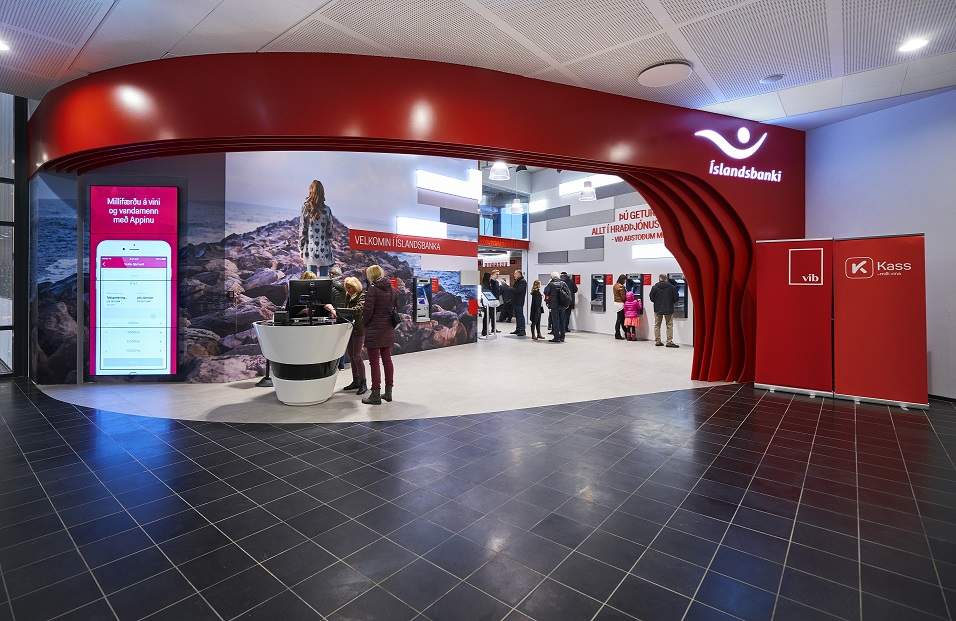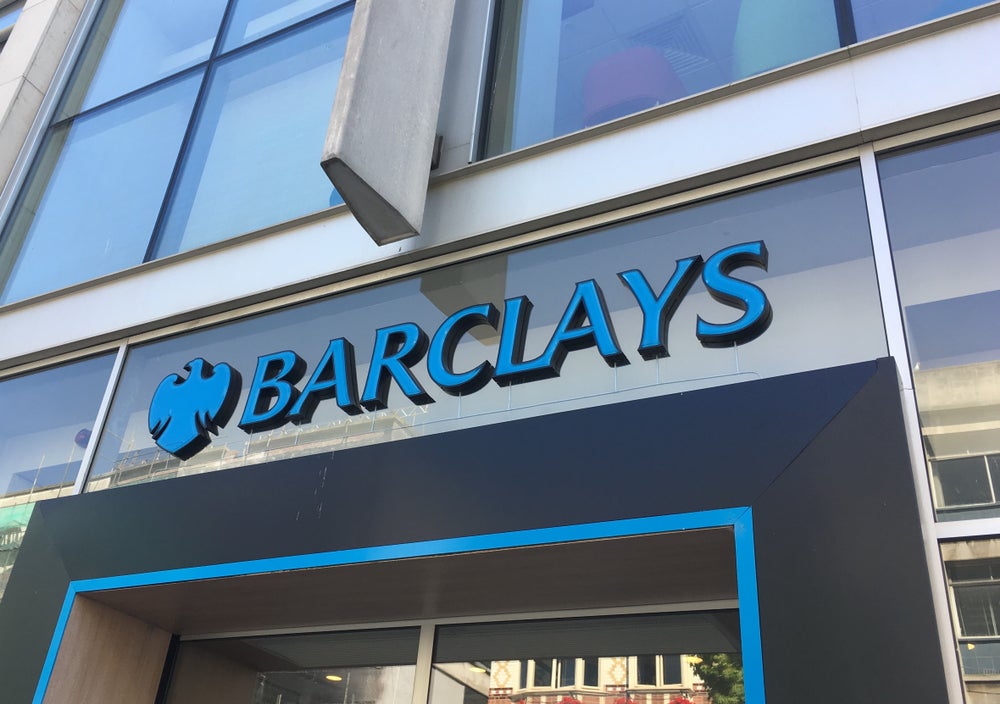
With a mere 14 branches, only 18% of Iceland’s total branch network, Íslandsbanki has the country’s most efficient network boasting a 30% retail banking market share. Its branch offering has now been boosted by a stunning new head office branch situated in Reykjavik’s tallest building, reports Douglas Blakey
Islandsbanki’s new flagship branch is to be found just below the bank’s head office.
The branch merged three existing branches -, Parabakki, Digranesvegur, and Garðatorg – into one state of the art outlet adjacent to a large retail mall complex.
Continuing a long and successful partnership that commenced back in 2007, Íslandsbanki turned to UK-headquartered design agency allen international to craft the new outlet.
The aim: to deliver a strong financial centre offering comprehensive financial consultancy services to the bank’s customers. All of the branch’s design and functionality takes account of flexible structure, new technology, effective consultancy and a positive customer service experience.
The result is a fresh retail concept centrally located in the capital area, close to retail shopping centres and residential and commercial communities.
How well do you really know your competitors?
Access the most comprehensive Company Profiles on the market, powered by GlobalData. Save hours of research. Gain competitive edge.

Thank you!
Your download email will arrive shortly
Not ready to buy yet? Download a free sample
We are confident about the unique quality of our Company Profiles. However, we want you to make the most beneficial decision for your business, so we offer a free sample that you can download by submitting the below form
By GlobalDataThe demands made of the design strategy lay in the need to expand on the modern retail environment that was created in the bank’s Grandi branch and again reach out to the local community.
In addition, the operating environment had to be capable of facilitating the high levels of relationship management and service levels to which the bank aspired.
It also reflects the bank’s strong commitment to social media. A fundamental goal for the design was to ‘Deliver No1 Service’ in the local banking market.
Driven by this vision, the bank’s business model is based on four traditional business divisions that together with the Relationship banking division drives how it builds relationships with its customers, simplifies its product offering and unifies its objectives with society at large.
That is summarised by the bank as: multipy, simplify and unify.
The design is expanded upon three distinctive, inter-linked zones:
A ‘Quick Serve zone’ at the front of the branch integrates facilities for self-service and a quick-service or enquiry desks staffed by universal bankers.
This provides a fast and efficient operational space to serve customers’ everyday banking needs by assisting them in the use and promotes adoption of self-service channels while promoting financial products.
The ‘Community Lounge’ is located at the heart of the ‘Islandsbanki’s branch in North Tower. This offers a relaxed, purposely homely environment where customers can relax, enjoy complimentary coffee, socialise, and chat to the branch hosts.
A key component of this space is the showcase and access to the banks social media channels. The bank has become a major digital communicator and each branch is represented on Facebook.
The branch offers a wide range of events for customers and the community, discussing financial services or other business topics. In addition, the public space of the branch provides an important venue and showcase for the banks own equivalent of ‘Ted Talks’, and seminars.
The final area, set off the central community lounge, is the ‘Engage & Advise’ zone. Consulting staff share agile meeting spaces, meaning they are each provided a dedicated workspace within the back office, coming forward when meeting customers in one of the shared cabin like meeting booths.
This greatly improves operational efficiency and optimises retail space allocation, but also fundamentally shifts the focus of the one to one meetings according to the needs of the customer. A meeting room is situated above consultation rooms, which are built into a free standing structure in the centre of the branch, provide a focal point for the space and injects a sense of theatre into the design.
The meeting rooms will continue to be a unique brand signature of the designs for future Islandsbanki branches, providing their own aesthetic for the spaces and a talking point for customers who visit.
Una Steinsdóttir, Director of Retail Banking at Islandsbanki said:
“We are very proud of our new branch in the North Tower, where we meet the needs of Íslandsbanki customers. Providing high-level service will be our main role as we work towards our objective of meeting our customers’ needs and demands.
“Even though digital banking has advanced by leaps and bounds, demands for high-quality personal service have not diminished; they have changed. In the North Tower branch, we offer expert services from the branch’s certified financial advisors while also increasing options for all self-serve banking.
“For instance, special express service representatives will be available to assist our customers in order to make their visit to the branch as pleasant as possible. We place strong emphasis on giving our customers a positive banking experience.”
The crisis 10 years on: Iceland’s banks well on the mend
By contrast to other troubled banking markets – the UK and Ireland are as good an example as any – Iceland went about things rather differently.
Banks failed and bankers went to jail.
The country’s financial sector was dominated pre-crisis by three lenders: Glitnir, Kaupthing, and Landsbanki.
In October 2008, Iceland’s Financial Supervisory Authority took control of the three banks with two of the three brands destined to be axed: Kaupthing rebranded as Arion and Glitnir re-branded as Islandsbanki.
Landsbanki became the current day Landsbankinn, opting not for a full rebrand but instead set itself the massive challenge of re-buidling its tattered brand reputation.
At the time of the banks’ collapse, Kaupthing was the largest of the three banks by assets ($83bn) ahead of Landsbanki and Glitnir with assets of $50bn and $49bn respectively.
While those figures pale into comparison with, say, Washington Mutual ($328bn of assets pre-bankruptcy), it ought to be remembered that Iceland is a country of little over 300,000 people.
Iceland’s three banks were worth roughly 12 times the country’s GDP and worth 20 times the state budget.
In the UK, Royal Bank of Scotland CEO Fred Goodwin lost one-half of his pension and his knighthood; in Iceland, there were almost 30 banking prosecutions. In one country, a manager in the finance ministry was imprisoned: it was not the UK.
Unlike the UK (and other major markets) Iceland did not bail out its banks or bankers.
The government separated domestic deposits and froze payments to international depositors; it borrowed heavily from the IMF, rebuilt its financial system and imposed strict capital controls.
Today, the three Icelandic banks are of roughly equivalent size ranked by assets with Landsbankinn marginally the largest with assets of ISK1.27trn ($11.1bn).
And the country is arguably stronger than ever.
The branch networks of the three banks appear at first glance to be modest: Landsbanki has just 37 branches ahead of Arion with 24 and Islandsbanki with a mere 14.
But by international comparison, for a country today of around 334,000 people, 75 branches in total suggests there is scope for branch rationalisation.
Islandsbanki’s three branches into one initiative offers its two rivals food for thought.
With two of the three banks reporting cost-income ratio’s in excess of 60%, further cost savings from branch rationalisations can be expected.
Ranked by retail banking market share, Landsbanki has almost 39% ahead of Isalandsbanki with 30.3% and Arion’s 28.1%.







